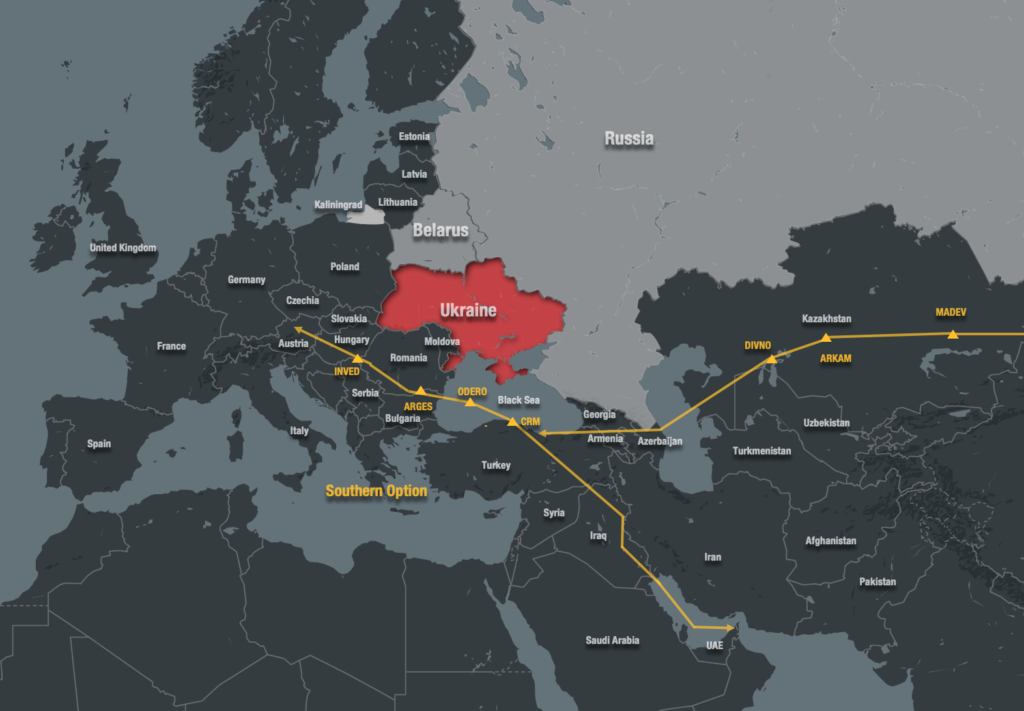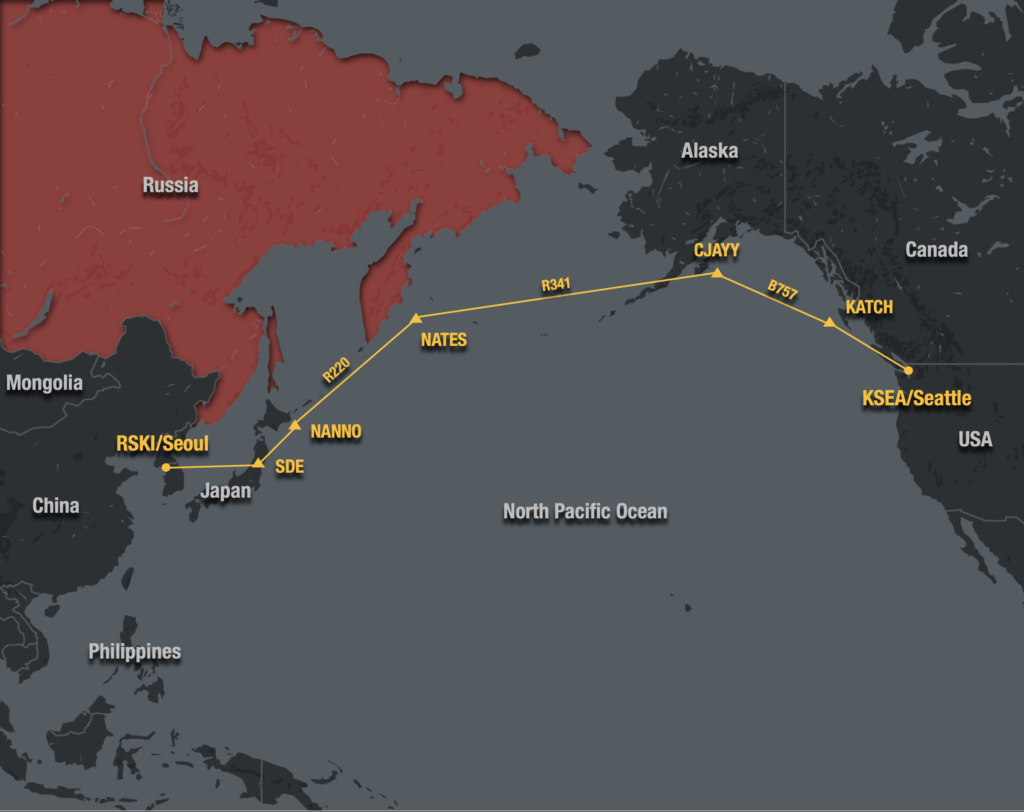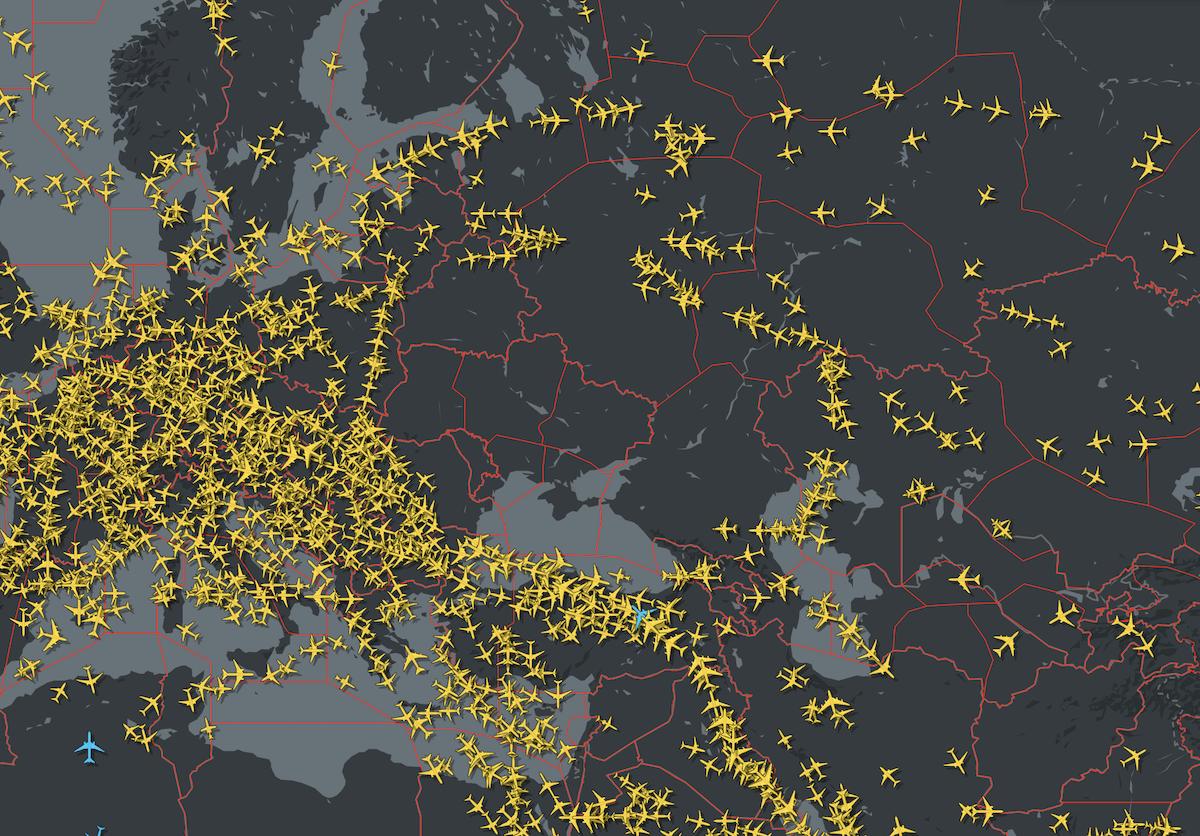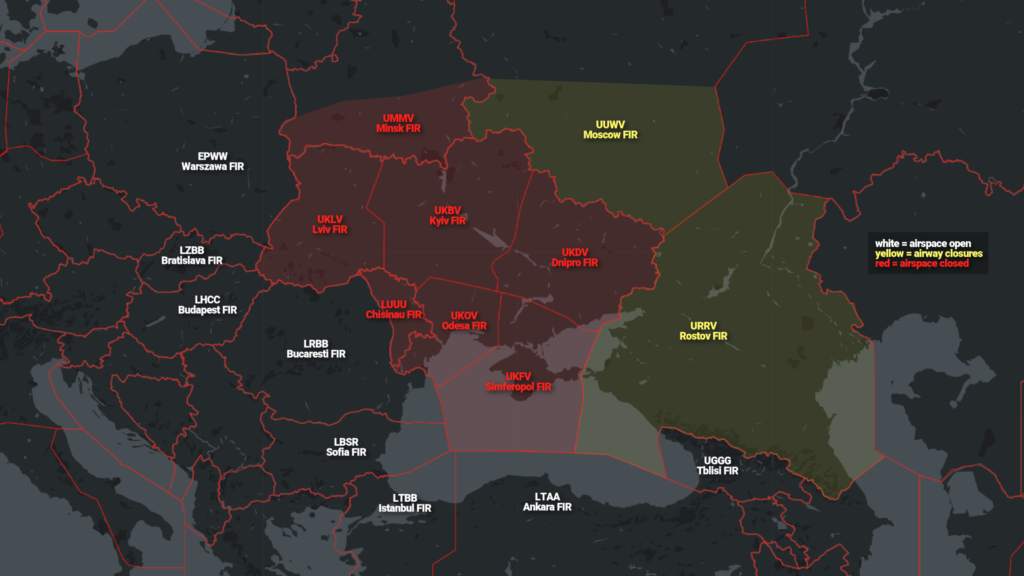Here’s everything we know right now about the Ukraine/Russia situation with regards to the impact to international flight ops. We’ll edit and add to this post as more information becomes available.
The main topics:
- Ukraine, Moldova, Russia and Belarus airspace closures.
- Which countries have banned Russian aircraft and operators, and which countries has Russia banned in response?
- The differences between the sanctions imposed on Russia by the US, the UK, and the EU, and the nuances of how these sanctions may impact your flight.
- Considerations for operators now looking to route around Russian airspace.
- Information on Humanitarian relief missions.
Airspace closures
These are pretty well known by most of us at this stage, but just to reiterate:
- The entire airspace of Ukraine remains closed to all civil flights.
- The airspace of Moldova is also closed, but they have been accepting flights to LUKK/Chisinau Airport on a case by case basis (we’ve seen several cargo flights go in there in the past week). But you have to apply to the Ministry of Defence and sign a declaration accepting “the risks that may arise as a result of operating in conflict areas”. So that’s a pretty stark warning of the risk of operating in here at the moment.
- Belarus has closed the southern half of its airspace along the FIR boundary with Ukraine.
- Russia has closed most airways in the URRV/Rostov FIR and in the southern part of the UUWV/Moscow FIR.
Here’s what all that looks like:
Reciprocal bans on aircraft/operators
Several countries have now banned Russian aircraft and operators from their airspace – The European Union along with some non-EU countries, the US, Canada, the UK, along with some Caribbean states – Anguilla, Aruba, Bermuda, British Virgin Islands, Cayman Islands, Turks and Caicos.
In response, Russia has banned aircraft and operators from most of these countries from Russian airspace, announcing the bans via Notams under the UUUU code. The notable exception, so far, is the US.
However, several local agents in Russia have reported that that they are not able to provide Russian landing and overflight permits to US registered aircraft and operators, and we’ve had similar reports from some locally based OPSGROUP members. With all US airlines avoiding Russian airspace, that is sensible action to follow given the uncertainty.
To keep updated on which countries have issued bans for Russian aircraft/operators, and which countries Russia has banned in response, Makgas are keeping an updated list here.
UK/US/EU sanctions
The EU, the UK and the US have each taken different approaches with their sanctions in terms of how they impact jet travel.
The US – For aircraft not registered in Russia – there’s now a list online, published by the International Trade Administration, and if your aircraft is “owned, chartered, leased, operated or controlled by, for, or for the benefit” of someone on that list, you can’t operate “to, from, within, or through” US territorial airspace. For more info on this, check our dedicated article here.
The UK bans aircraft owned, operated or chartered by anyone connected with Russia or designated individuals or entities – but unlike the US they haven’t published a list of who those individuals or entities might be. You can see the most recent UK announcement on this here.
The EU rules are the least specific – essentially the ban in Europe applies to Russian passport holders, even dual citizens. So Russian citizens can still travel as passengers, but they can’t charter the plane (and EU companies/people can’t charter it on their behalf either). You can read the EU’s official announcement here.
There have been a couple of incidents over the past couple of weeks where certain operators have fallen foul of the rules pertaining to sanctions.
- Canada: a Falcon 900 registered in the Cayman Islands was detained at CYZF/Yellowknife airport, along with its crew and passengers, after landing from Geneva. The aircraft was released and flew back to Europe later that week, but the Russian charter customer was fined $3,000, as was the jet’s pilot. And the aircraft’s owner was fined $15,000.
- The UK: a Global 6500 registered in Luxembourg was detained at EGLF/Farnborough airport because the authorities suspected it was linked to a Russian oil tycoon. The aircraft will only be allowed to leave Farnborough if the inquiry they’ve set up shows it is not a Russian-owned or controlled jet.
The bottom line – don’t charter a sanctioned aircraft, and make sure that you don’t charter your aircraft to a banned individual or entity. The potential impact to getting this wrong could range from having your payments frozen, to fines, to potentially having your aircraft impounded somewhere.
Routing around Russian airspace
“Is it safe to overfly?” and “Is it safe to land” are in many ways the same question – because if you’ve elected to fly over a certain bit of airspace, and something goes wrong, the chances are you’re going to be landing there. Most operators are now avoiding Russian airspace, either because they’re banned from it, or because they’ve decided the risks of having to divert to Russia are too high.
Europe focus:
European carriers are generally having to change more routes than the US airlines… but higher fuel costs of having to route around Russia are offset against the fact that they’re now saving thousands on not having to pay Russia overflight nav fees.
Options to overfly Europe have become increasingly complicated – especially for aircraft transiting between Western Europe and the Middle East and Asia. Major carriers in the region now appear to be following two major air corridors – one that extends from the Persian Gulf to Romania, the other from China to the Black Sea. Here’s what that looks like.

These routes take aircraft in close proximity to several danger spots, including Iraq, Iran, and Syria. For more info on this, check out the article we wrote here.
US focus:
A lot of US airline flights won’t be too badly impacted from their current levels – flights to the likes of China, Hong Kong, Japan, South Korea – just because they weren’t doing that many flights here anyway because of Covid restrictions.
From a routing point of view, there’s not a lot of impact to flights from the US to Europe, even the US to the Middle East – heading East is not an issue because there’s really only Russia’s Kaliningrad FIR to watch out for.
But for US flights heading West, avoiding Russian airspace does have an impact – routing via the NOPAC routes, down to Japan and China. There’s a 1700nm stretch of airspace here between PADK/Adak in the Aleutian Islands and RJCC/Sapporo in Japan where your options are extremely limited except for airports in Russia (mainly UHPP/Petropavlovsk, but also UHSS/Sakalin Island just before you get to Japan).
 The considerations for general/business aviation are different to the airlines here – it’s more a question of do you have the aircraft range to safely operate this section of airspace over water? And do you have decent divert alternates available in case you need them, to ensure that you don’t find yourself 3 hours away from a non-Russian airport in a 1LE scenario?
The considerations for general/business aviation are different to the airlines here – it’s more a question of do you have the aircraft range to safely operate this section of airspace over water? And do you have decent divert alternates available in case you need them, to ensure that you don’t find yourself 3 hours away from a non-Russian airport in a 1LE scenario?
Ukraine Relief Missions
Humanitarian flights for Ukraine are taking place into Poland, Romania and other neighbouring countries. We have compiled a list of handy contacts, general ops information, and other bits which we hope might help – you can read the article here.
The two agencies we’d encourage people to go check out are Airlink and DirectRelief – these two have already flown in shipments of aid and have more scheduled this month. So those are good places to go find out exactly what’s needed, and how to help.
IFALPA and the European Cockpit Association have also put out a letter for members of the aviation community wanting to help support the pilot community in Ukraine. They suggest you reach out to local organizations to help, or donate to larger ones such as Red Cross who are on the ground there. You can read the letter here.
If you need assistance with anything to help prepare for humanitarian flights, please get in touch. Similarly, if you have already operated similar missions, please get in touch to share your contacts, feedback and experience so we can support others in their operations as well.
CofA’s revoked!
A final word on this. We put it right down here at the bottom because although it’s fairly big news and worth knowing about, it probably won’t impact your operation very much.
Aviation authorities in Bermuda and Ireland have now revoked airworthiness certificates for leased aircraft detained in Russia – mainly because they’re no longer able to check these aircraft to see if they are still airworthy. They’ve done this ahead of the March 28th deadline set by the EU to terminate leases and recover planes from Russian airlines.
From most reports, it seems there are around 500 aircraft owned by foreign leasing companies which are rented to Russian operators.
The response from Russia has been to create a new law which basically allows Russian carriers to re-register these aircraft, and continue operating them domestically – despite the termination of the leases. And reports suggest something like 200 of these aircraft have already been re-registered in the past week.
Added to that, all the major manufacturers are now no longer supplying spare parts to Russia. Airlines and operators using these aircraft in Russia will therefore almost immediately have the issue how to keep them functioning and airworthy, but the point worth noting for all the rest of us is this – do you want to risk potentially having to divert somewhere where your aircraft might get stuck on the ground with a tech issue that can’t be fixed?
Ultimately, we’re now approaching a situation in Russia very similar to the Soviet Union days. Russia is essentially now in the same basket as Iran and North Korea in terms of being shut off from the rest of the aviation world, and operators need to plan accordingly.
More on the topic:
- More: Ukraine-Russia Spillover Risks: Nov 2022
- More: Is the Fuel Pool Drying Up?
- More: Russian CAA website taken offline
- More: Ukraine Relief Missions
- More: Spillover Effect: New Airspace Risks in Europe
More reading:
- Latest: Teterboro: RIP the RUUDY SIX
- Latest: 400% increase in GPS Spoofing; Workgroup established
- Latest: GPS Spoofing WorkGroup 2024
- Safe Airspace: Risk Database
- Weekly Ops Bulletin: Subscribe
- Membership plans: Why join OPSGROUP?












 Get the famous weekly
Get the famous weekly 





